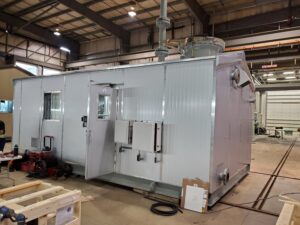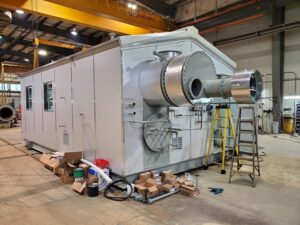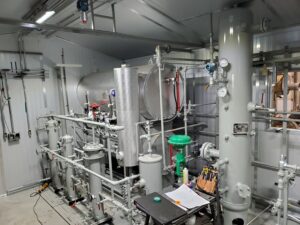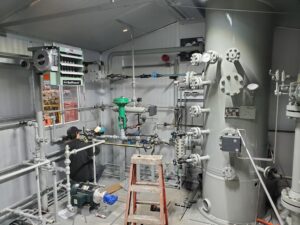
Photo shows the break flange that allows in-shop hookup of instruments and controls for quicker installation and lower field costs.
A properly remanufactured system provides lower cost, shorter delivery and like-new or better performance.
Above are photos of a recently completed glycol dehydrator rebuild for a Canadian client (36″ sour, flanged tower unit) over the summer of 2021 for fall installation. The project was both on time and on budget. We sell increasingly more as timelines are becoming tighter due to supply chain issues, while gas prices are improving steadily.
How does OilPro supply remanufactured glycol dehydrators?
The procedures below will explain better why we always bring glycol dehydrators in for remanufacturing: A dehydrator sold by OilPro goes through a series of steps for both trayed and packed column systems.
Over the last 25 years, we’ve seen almost every “field-run” dehy experiment, where an producer buys an “as-is” field-run dehy in the hopes of being able to connect it and use it right away, end with problems and unforeseen costs. This is why field-run dehys are so cheap.
Unless it can be run and tested for circulation it’s really hard to tell a dehy’s condition. Many units built in the past were built to look good on a bid spread, rather than be serviceable in the field.
Specifically because they were hard to service due to generally being built fast and cheap, older units have not seen the maintenance work they require to operate reliably.
Issues include:
- Reboilers plugged with asphaltenes and unservicable without partial enclosure disassembly
- Wax, rust, sediment buildup that chemical circulation can’t fix.
- Plugged media trays and downcomers
- Poorly run units with trays rammed into the top of towers
What problems can used glycol dehydrators exhibit?
Many glycol piping systems leak if the lines weren’t back welded, and many are plugged or restricted after years of use or sitting idle. (Many smaller dia. dehys end up being used as separators at the end of their lives as more centrally-located larger dehydration replaced them).
This is why we replace most if not all of the flowlines and make the overflows between the accumulator and reboiler easily serviceable with an externally accessible system designed through operator input and years of customer and operator and startup expert feedback.
One might say that with these improvements by the time we’re done with them they work better than they did when they left the factory.
The OilPro-approved glycol dehydrator remanufacturing process:
The following ensures successful remanufacturing of glycol contactors & reboilers, instrumentation, piping, controls and valves and/or electrical scope:
Glycol Contactor
1. Obtain original Manufacturers Data Report from the jurisdiction the vessel was constructed in.
2. External visual inspection of the contactor. Looking for obvious dents and gouges in the vessel shell. Each nozzle is inspected looking for damaged flange faces and bent nozzles. Each coupling is inspected looking for damaged threads.
3. Internal visual inspection through nozzles and couplings to determine the condition of the demister pad, trays or packing, internals, and overall cleanliness.
4. Conduct an ultrasonic inspection (UT) of the vessel shell by a certified third part inspection company to determine the shell thickness. This is compared to the original Manufacturers Data Report.
5. The contactor is internally cleaned by means of steam, hot water, solvent, chemical, heat, or combination thereof.
6. For contactors with trays, the trays are removed and replaced. If the contactor does not have manways to facilitate tray removal, the contactor shell is cut in strategic locations to allow the removal and replacement of the trays.
7. For contactors with packing, the packing is removed and replaced.
8. After the trays or packing are removed (including the demister pad), the internal shell wall of the contactor is thoroughly cleaned and then examined for any evidence of pitting or corrosion. Any defects are repaired and magnetic particle inspected (MPI).
9. Nozzles and couplings are repaired or replaced as necessary.
10. A new demister pad is installed and new trays are installed.
11. The contactor shell is welded where cut apart, NDE, PWHT (if required), and a pressure test completed.
12. Gas to glycol exchanger is pressure tested.
Glycol Reboiler

This shows the reboiler and flame arrester. This unit was extended to provide additional BTU capacity.
1. Disassembled completely, internally cleaned and visually inspected. All internal defects are repaired.
2. Fire tube removed, externally sandblasted and internally cleaned. Visually inspected and all welds magnetic particle inspected (MPI). All defects repaired.
3. Flame arrester removed cleaned and visually inspected. Defective flame arresters are replaced.
4. Reboiler still column is removed, packing removed, and internally cleaned and visually inspected. All defects are repaired. Economizer coil (if equipped) is inspected and pressure tested. New packing (ceramic saddles or stainless steel Rasching or pall rings) are replaced.
5. Reboiler accumulator coil is removed, cleaned, visually inspected, MPI, defects repaired, and pressure tested. If the reboiler accumulator coil was not originally flanged, the coil is cut out and a new maintenance flange added.
6. Reboiler accumulator is internally cleaned and visually inspected. All internal defects are repaired.
7. Reassemble the fire tube, flame arrester, still column, and accumulator coil and pressure test the glycol reboiler with air to 5 psig (35 kPa).
8. Burner fuel gas system upgraded to meet the requirements of Canadian Standard CSA B149.3 – Field Approval of Gas Fired Appliances.
Instrumentation

This shows the external overflow and the glycol flash separator as well as reboiler, accumulator and filters
1. Glycol pumps removed and rebuilt by a certified pump repair shop.
2. Glycol filter canisters cleaned and visually inspected. All filters replaced.
3. Pressure safety valves (PSVs) removed and reset by an ASME certified PSV repair shop. Calibration certificates provided.
4. Gas meter run is removed and sent to a certified meter run remanufacturer for recertification to the latest AGA standard.
5. Instrument controllers and end devices removed, refurbished or replaced, and recalibrated where required.
6. Control valves are removed and refurbished by a certified control valve remanufacturer. Quality control documentation provided where required.
7. Instrument tubing and fittings replaced where required.
8. Burner Management System (BMS) added and function tested to meet the requirements of CSA B149.3.
Piping and Manual Valves
1. Large bore piping disassembled and visually inspected. Defective piping is replaced as required.
2. Small bore piping is replaced.
3. Large and small bore valves are removed cleaned and visually inspected. Defective valves are replaced.
Electrical (if equipped)
1. Electrical equipment is visually inspected and function tested. Defective equipment and systems are replaced.
2. High voltage systems are Megger tested for insulation resistance. Defective wiring is replaced.
3. Low voltage systems are loop checked to confirm the components are wired correctly and the system is functioning as designed.
OilPro provides both new and re-manufactured towers combined with remanufactured skid components to make a like-new dehydration unit.
Each come with a one-year OilPro-backed warranty.
Options for dehydrators include flash gas separator, various pump configurations and 8-10 tray configurations. Towers and re-boilers can be configured to specific project requirements.
Visit our dedicated dehydrators page for more information and for specific models available. We’ve also written an article on a specific 36″ split tower glycol dehydration system project that we remanufactured.

